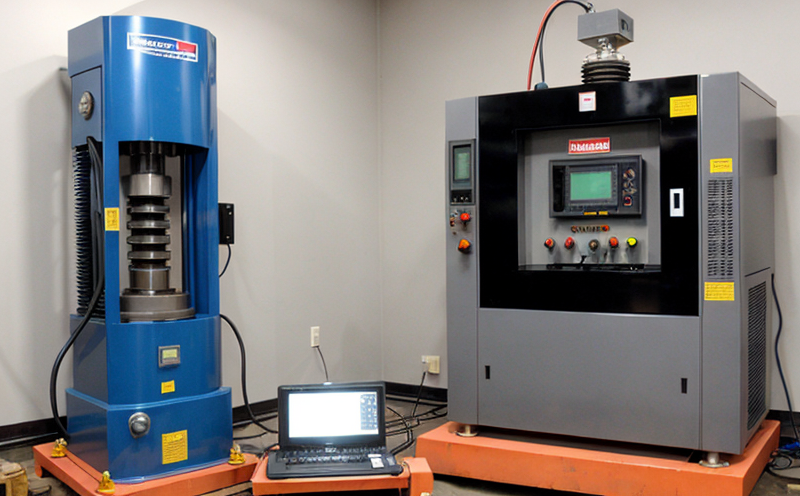MIL STD 901D High Impact Shock Test for Naval Equipment
The MIL STD 901D high impact shock test is a crucial procedure in the aerospace and defense sectors, designed to evaluate the durability of equipment under extreme mechanical shock and vibration conditions. This test ensures that components used in naval applications meet stringent requirements set by military standards, thereby enhancing reliability and performance in harsh environments.
The test involves subjecting a specimen to controlled shock inputs over a specific frequency range and at defined levels. The purpose is to simulate real-world conditions encountered during transportation, handling, or deployment on naval vessels. MIL STD 901D encompasses several environmental tests including vibration, temperature cycling, salt fog, humidity, altitude, and high/low pressure testing.
The high impact shock test focuses specifically on the specimen's ability to withstand mechanical shock pulses without sustaining damage that would compromise its operational integrity or safety. This is particularly important for naval equipment where failure can have severe consequences. The test parameters are meticulously defined in MIL STD 901D, ensuring consistency and reliability across different laboratories.
For the high impact shock test, a specialized machine generates controlled shock pulses of varying amplitudes and durations. Specimens undergo testing at specified frequencies to ensure they meet the required performance criteria. The machine is calibrated according to established standards such as ISO 2631-1 or ASTM E1045, ensuring accurate and repeatable results.
The test procedure involves careful specimen preparation, including cleaning and marking, followed by mounting on a suitable fixture. Once mounted, the specimen undergoes loading with specified weights and is subjected to shock pulses using a drop hammer or similar equipment. The number of pulse tests conducted depends on the specific requirements outlined in MIL STD 901D.
Post-testing inspections are critical to determine whether the specimen has sustained any damage. This includes visual inspection, measurement checks, and functional testing to ensure that the equipment continues to perform as expected after exposure to shock conditions. The results of these tests are meticulously documented and reported according to MIL STD 901D guidelines.
The importance of this test cannot be overstated, especially in naval applications where equipment must withstand rigorous conditions. By adhering to MIL STD 901D standards, manufacturers can ensure that their products meet the highest quality and reliability expectations set by military requirements.
| Test Parameters | Description |
|---|---|
| Shock Pulse Amplitude | Varies based on specimen type and environmental conditions |
| Pulse Frequency Range | Defined by MIL STD 901D to simulate real-world conditions |
| Number of Pulses | Determined by the specific requirements of the test |
| Specimen Fixtures | Customized based on specimen geometry and material properties |
The meticulous nature of this testing ensures that only the highest quality equipment is used in naval applications, enhancing safety and reliability. By adhering to MIL STD 901D, laboratories can provide assurance that their clients' products are capable of withstanding harsh environmental conditions, thereby meeting military standards.
Industry Applications
- Military grade electronics and equipment
- Naval vessel components
- Aerospace instrumentation for naval use
- Defense systems requiring durability in harsh conditions
The MIL STD 901D high impact shock test is essential for ensuring the reliability of electronic devices used in naval applications. This includes communication equipment, navigation aids, and other critical systems that must operate efficiently under extreme shock and vibration. By testing these components according to MIL STD 901D, manufacturers can ensure their products meet stringent military standards.
Naval vessel components such as sensors, actuators, and control systems benefit greatly from this testing. These components are often subjected to significant mechanical stress during deployment and operation at sea, making the ability to withstand high impact shocks crucial for maintaining functionality and safety.
Aerospace instrumentation designed for use in naval applications also undergoes MIL STD 901D testing. This includes sensors used in aircraft carrier operations, navigation devices, and other critical systems that must function reliably under harsh environmental conditions. By ensuring these components meet the required standards, manufacturers can provide equipment that is trusted to perform as expected.
Defense systems requiring durability in harsh conditions are another key area of application for this testing method. These systems often operate in environments where exposure to high impact shocks and vibrations is common, making MIL STD 901D testing essential for ensuring their reliability and safety.
Customer Impact and Satisfaction
The MIL STD 901D high impact shock test significantly impacts customer satisfaction by ensuring that the equipment they procure meets or exceeds military standards. This testing process provides confidence to customers that their products are capable of withstanding harsh environmental conditions, thereby enhancing reliability and safety.
By adhering to MIL STD 901D guidelines, laboratories demonstrate a commitment to quality and accuracy, which is crucial for the trust placed in them by defense contractors and other stakeholders. This ensures that the equipment they supply meets the stringent requirements set forth by military standards, thereby enhancing customer satisfaction.
The results of this testing are critical for customers who need to ensure their products perform reliably under extreme conditions. By providing accurate and repeatable test results, laboratories can help customers make informed decisions about their procurement needs, leading to higher levels of customer satisfaction.
International Acceptance and Recognition
- MIL STD 901D is widely recognized by military organizations globally for its stringent testing standards.
- The test procedure has been adopted by numerous countries as a benchmark for evaluating the durability of electronic equipment.
MIL STD 901D high impact shock tests are highly regarded in the international community, with many countries adopting it as a standard for evaluating the durability and reliability of electronic devices. This recognition underscores its importance in ensuring that products meet stringent military requirements.
The test procedure has been standardized by ISO and ASTM, further enhancing its credibility and acceptance worldwide. Laboratories accredited to perform this testing are recognized globally for their expertise and precision, providing clients with assurance that they are receiving the highest quality services.





